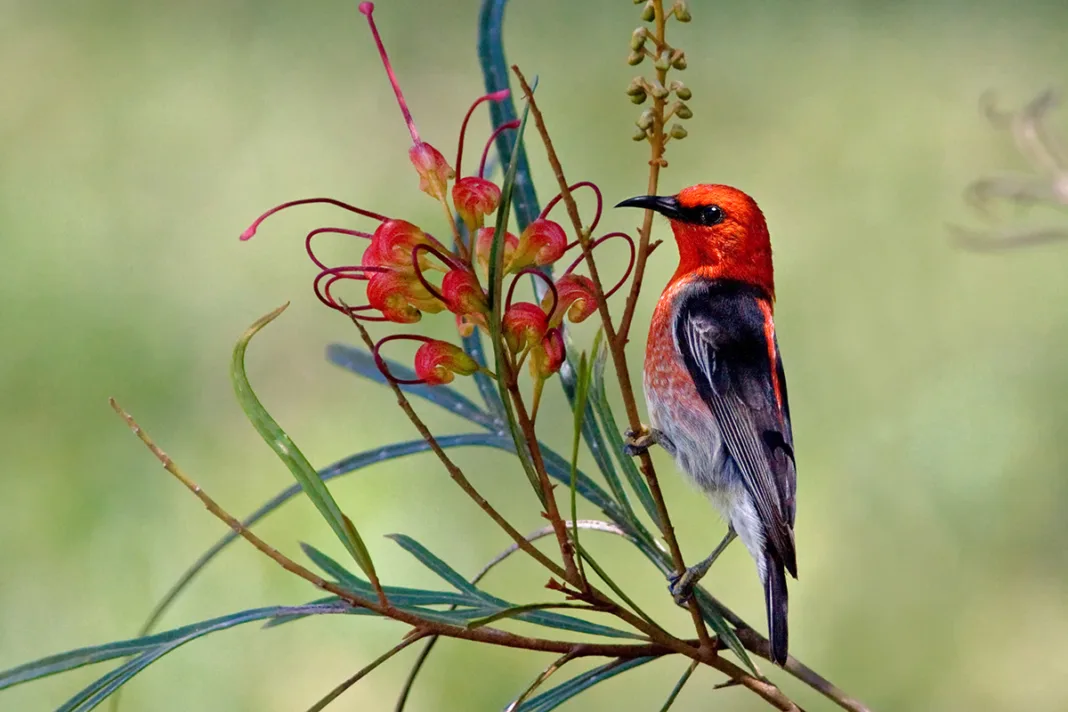So what does a scarlet honeyeater eat? The answer, says top Australian softbill man JOHN KEARNEY, is more complex than you might think.
The scarlet honeyeater (Myzomela sanguinolenta) is omnivorous, feeding on insects as well as nectar. Birds usually forage in the upper canopy and rarely on the ground. They are seen foraging in pairs or small groups through flowers and foliage.
Their native diet includes insects, nectar and honeydew, and some ripened fruits are also taken. Some of the flowering trees that this species feeds on include melaleuca, eucalypts, callistemon, grevillea, native heath, hakea and mistletoe. Butterflies, ants, bugs, beetles, moths, bees and wasps are attracted to pollen and nectar produced by the aforementioned trees. These items form an invaluable food network, not only for this honeyeater but for numerous other bird species, marsupials and bats.
Nectar is made up of water and sugars, with small amounts of other food substances. These sugars provide the energy needed for their vigorous activity, but do not provide them with protein, vitamins and fats required for the growth, repair and functioning of their tissues.
Insects and pollen provide scarlet honeyeaters with the nutrients required to maintain their active lifestyle. Their tongue is long and has a brush tip, fringed with bristles, which works like a paint brush to soak up nectar by capillary action. Some honeyeaters have been recorded licking at a rate of more than 10 per second!
A honeyeater’s alimentary tract is also adapted for nectar in an arrangement that lets liquid pass directly to the intestines but separates material that requires more digestion – such as insects caught during feeding – to be retained in a separate chamber for the stomach. We need honeyeaters in our bush and gardens since, they control insect numbers; without control, some of these insects could be detrimental to our flora. Examples of these insects are psyllid and lerp, which are insects which the scarlet and many other honeyeaters consume. Psyllid are tiny sap-sucking insects that damage plants by sucking sap from their leaves. Some immature psyllids form a protective covering of crystallised honeydew inside which they feed and shelter, and these are called lerp. In situations where psyllid attack has been particularly severe, trees may die after being weakened and then invaded by secondary insect pests. All honeyeaters feed on insects, particularly before and during breeding.
In captivity, the scarlet honeyeater feeds on a nectar mix in drinking tubes placed at different heights. On extremely hot days, the nectar mix is given morning and afternoon. The reason for this is that the mixture gets hot and starts to ferment and go “gluggy”. Lory dry food is available and is readily consumed. Livefood available for my scarlets includes termites, maggots, ferment fly, housefly, fly pupae and moths. All of these are keenly sought after by this species. The scarlets and many of the honeyeaters that I keep are eager to consume the softfood mix I make.
Ripened fruits are also included in the diet, and they have a particular liking for orange. Livefood is given in trays that are raised off the ground, since this species prefers to take food at elevated locations, and in my experience rarely visits the ground. Flowering callistemon, grevillea, banksia, and eucalypt branches are provided when available, suspended in conduit tubing. Fire ash, crushed charcoal and crushed cuttle bone are also provided. I have observed this species taking all of these items, with a fondness for fire ash.
Boosting the nutrients
Over the past three years I have been doing a lot of research on the diet of honeyeaters in captivity. The research shows that most honeyeaters and hummingbirds kept in captivity were suffering from deficiencies of thiamine and, to a lesser degree, magnesium. The challenge then was to find something that contains these valuable nutrients and work them into my feeding regime. After a lot of searching, I came up with the Berocca performance tablet. This has all the nutrients that I required plus a few extra. I use one orange tablet to one nectar mix; this makes approximately 2 litres of nectar mix, which I provide once a week. I have been using this method for the past 18 months, and all of my honeyeaters are thriving and have suffered no ill effects from this technique.
Find more news and articles like this on the Cage & Aviary Birds website. Subscribe to Cage & Aviary Birds magazine now.


